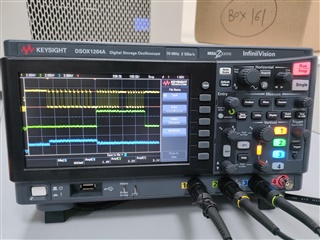Other Parts Discussed in Thread: SN75173, , SN74AHC125-Q1, TXU0204-Q1, TXU0304-Q1
Hello,
I have recently incorporated the TXB0104QPWRQ1 component into our design. Here is the circuit diagram. It essentially converts 5V to 3.3V.

VCC = 5V, 3.3CPLD = 3.3V
But it is not converting to 3.3V. The IC U42 in the picture is SN75173D, and the output (3.3V) of the level shifter goes to CPLD pins.
Could you please verify the circuit diagram? Do you see any issues with it?
Also, what if the SCLK_5V, SCTL1_5V, SCTL0_5V are at lower voltage i.e. 3.2V shown in picture below. As we are getting output of 1.2V Refer amplitude 2 (input to level shifter) and 3 (output from level shifter)

Do let me know.
Thanks,
Amol Bagul




